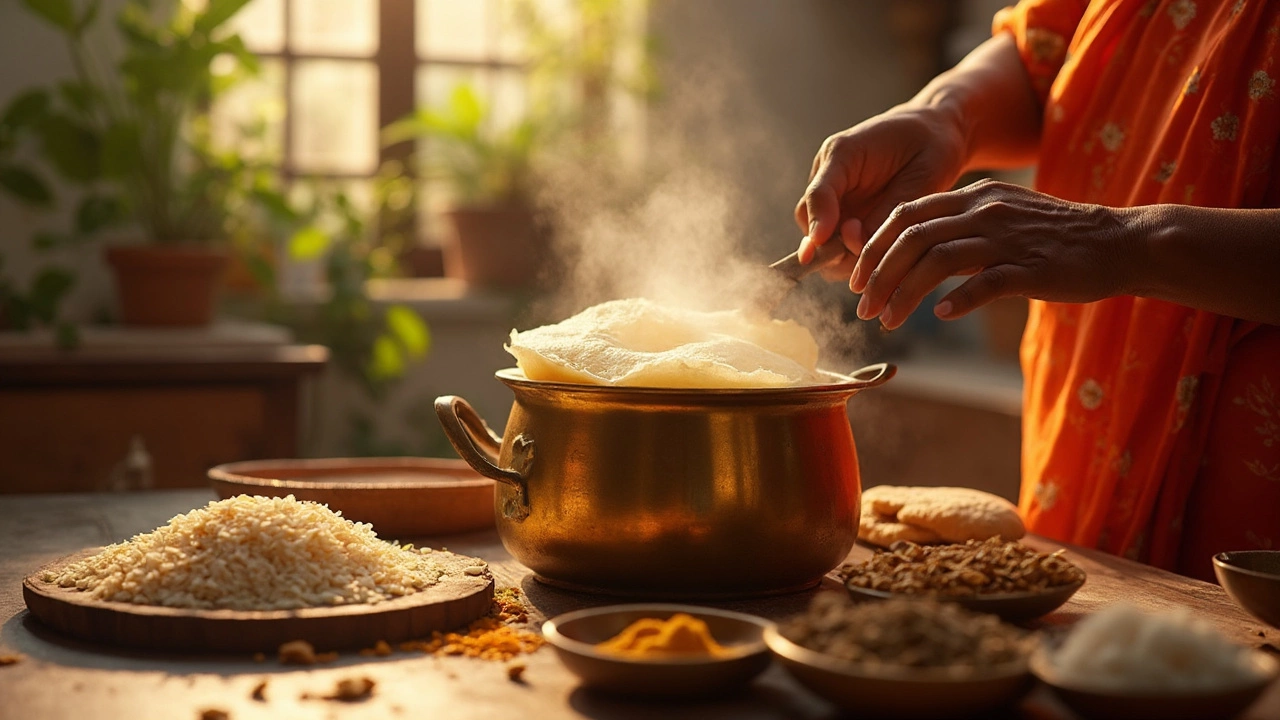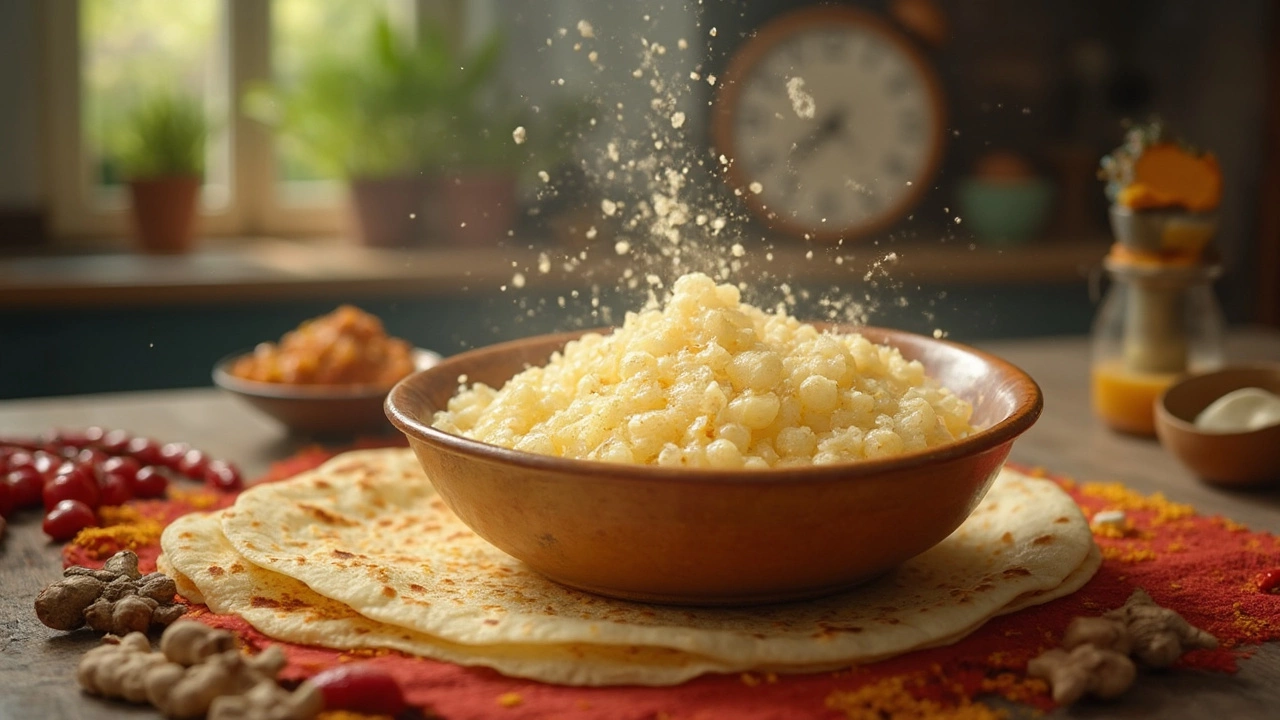Speed Up Your Dosa Batter Fermentation Without Using Yeast
 Feb, 18 2025
Feb, 18 2025
Ever been in the middle of a dosa craving only to realize your batter is still sitting there, unfermented? It can be frustrating, especially when time is of the essence. But what if you could speed up the fermentation process without adding yeast? It's totally doable, and I'm here to spill the beans.
First off, let's get on the same page about fermentation. It's basically the magic that turns your dosa batter from sticky rice and lentils into a light and fluffy delight. But often, it seems like nature itself decides to take its sweet time.
One of the biggest secrets? Temperature. If you're in a cooler climate or it's winter time and you're not getting the fluff you want, try popping the batter bowl into your oven with just the light on. This provides a warm environment that's just right for those little fermentation helpers.
- Understanding Fermentation Basics
- Choosing the Right Ingredients
- Temperature and Environment Hacks
- Storage and Timing Strategies
- Practical Tips and Troubleshooting
Understanding Fermentation Basics
Fermentation might sound like one of those complicated cooking terms, but it’s actually an age-old process that’s pretty straightforward. At its core, it’s about breaking down starches using naturally occurring bacteria and yeasts. When it comes to fermentation for dosa batter, the goal is to achieve a tangy taste and the perfect texture that cooks into crispy yet fluffy dosas.
So, what really happens during this fermentation magic? Simply put, the natural bacteria and yeast found in the rice and urad dal (the two primary ingredients) start converting sugars into acids. This not only gives dosas their distinct taste but also paves the way for that beautiful rise—a sign of well-fermented batter.
Seeing Fermentation in Action
Ever noticed those bubbles in your batter? That’s a visual sign of the fermentation process at work. It means the mixture is alive and kicking! The key is finding the right environmental sweet spot. Think of room temperature, but a bit cozy—ideally around 30°C (86°F).
Batter Consistency Is Key
Fermentation doesn't happen in isolation; the consistency of the batter matters too. It should be like a smooth pancake batter—not too thick, not too thin. If it’s too thick, the fermentation will be slow. If it’s too thin, you might end up with a runny mess.
Here's a quick pro tip: Before setting the batter aside for fermentation, give it a quick taste. You'll know it’s done when it starts tasting tangy, and it sort of blooms to about double its initial volume.
Basic Ingredients Behind the Magic
- Rice: Choose short or medium-grain white rice for optimal results.
- Urad Dal: This is the powerhouse that packs in proteins and aids fermentation.
- Fenugreek Seeds: A dash of these seeds not only aids in fermentation but also adds a nice flavor.
Once you get the hang of these basics, you're halfway to being a dosa master. Remember, practice makes perfect, and every batch brings its own lesson!
Choosing the Right Ingredients
All right, before we jump into fermentation magic tricks, let's talk about the building blocks: the ingredients. The type of rice and lentils you use can make a huge difference in how fast your dosa batter starts bubbling.
Rice Options
When it comes to rice, using parboiled rice or idli rice is often recommended. These types are descendants of ancient grains known for their fermentation-friendly properties. They're easier to break down, which means they kickstart the process better than standard white rice.
The Pulse of Lentils
Now, onto lentils. The traditional choice is urad dal, specifically the husked and split variety, commonly known as skinless black gram. This little pulse is a powerhouse for fermentation, providing just the right balance of flavor and action.
| Type | Fermentation Efficiency |
|---|---|
| Parboiled/Idli Rice | High |
| Standard White Rice | Moderate |
| Urad Dal (Husked) | Very High |
| Other Lentils | Low |
Boosting Agents
If you want to give your batter an extra boost, try adding a handful of soaked poha (flattened rice) or a spoonful of fenugreek seeds. Both are known to make the batter lighter and speed up fermentation due to their natural enzymatic properties.
Understanding these ingredients is the first step to getting that perfectly fluffy and tasty dosa quicker than you'd expect. By making these swaps, you're essentially setting up the best conditions for nature to do its thing.

Temperature and Environment Hacks
When it comes to getting that perfect dosa batter, temperature is your best friend or worst enemy. Forget waiting around; smart tweaks to your environment can do wonders.
Warm Up Your Space
The first trick is maintaining a warm environment. In colder months, you might find your dosa batter taking forever to ferment. An easy fix? Use your oven! Preheat it at the lowest setting for five minutes, then turn it off and leave just the oven light on. Pop in your bowl covered in a cloth and let it stay cozy and warm. It’s like giving your batter a little sauna session.
Harnessing Sunny Spots
If it’s a sunny day, make the most of natural warmth. Find the warmest spot in your home – often a corner where the sun streams in. Just make sure your batter is covered; direct sunlight can dry it out. A sealed container helps create a mini greenhouse effect, trapping heat and moisture.
Heating Pad Wonders
No sun? No problem! Try a heating pad. Set it to low, place your covered batter bowl on top, and let it gently warm. Just be sure to check now and then that it doesn't get too hot; you’re aiming for cozy warmth, not a sauna boil!
| Method | Time Efficiency |
|---|---|
| Oven Light | Fast |
| Sunny Spot | Moderate |
| Heating Pad | Fast |
Whether you're using the oven, sun, or heating pad, these temperature tricks can make your dosa batter ready in a fraction of the time it would have taken otherwise. Try them out the next time you find yourself tapping your foot, waiting for fermenting magic!
Storage and Timing Strategies
Getting your dosa batter to the right fermentation stage can be tricky, but with some thoughtful planning, you can make it easier. After all, nobody wants to end their day with batter that just won't cooperate!
Smart Storage Solutions
Once you've got your ingredients blended into that smooth, pourable batter, it's all about where you store it. A little known trick is using your fridge to keep things optimal. If you know your kitchen runs cold, once the batter starts fermenting, you can transfer it to the fridge to slow things down while maintaining its readiness. This is particularly helpful if you've got leftovers!
For those with time constraints, say you need the batter ready for an early breakfast, you can leave it out in a slightly warmer room overnight. Just keep it away from strong odors, as the batter can quickly absorb them.
Timing is Everything
If you really want to nail the fermentation timing, think ahead. Planning comes in handy when working around your daily routine. For instance, start the soaking process in the morning and blend it all by afternoon. This way, your batter gets enough time to rest and ferment by the next morning.
Moreover, remember, the less crowded your batter is, the better it ferments. Using a larger container allows it more breathing space, enhancing its ability to rise.
Predicting Fermentation with a Glance
In case you're unsure about the timing, there’s a visual cue that can help. We’re aiming for roughly double in volume. A reliable way to track this? Use a transparent container or mark the bowl at the starting level with a marker.
Using these storage and timing hacks ensures you have perfectly fermented batter every time, ready for those crispy, delicious dosas.

Practical Tips and Troubleshooting
So, you've done everything right, yet your dosa batter is still not cooperating? Don't worry, we've got you covered with some practical hacks and troubleshooting advice to get that perfect ferment.
Common Hurdles
First things first, sometimes it's the little things that trip us up. Is your water too chlorinated? Tap water that’s too hard can mess with fermentation. Try using filtered or boiled water for better results.
Add a Helping Hand
If you feel like nature isn’t doing its thing, you can give it a little nudge. A small pinch of sugar can jump-start the process, acting as food for natural bacteria. Or try adding a bit of older, well-fermented batter.
Timing is Everything
Not seeing bubbles? It might just need more time. Sometimes the room isn't warm enough to get things moving. Try keeping it wrapped in a blanket overnight for extra warmth.
Use the Right Vessel
The bowl or jar you're using might also be a factor. Fermentation loves breathing room! So make sure you're leaving enough headspace in the container. A larger bowl with more exposure to air can sometimes do the trick.
Storage Tips
If you make dosa batter frequently, consider keeping a little bit of old batter to mix with your new batch. This acts like a natural starter culture. Just be sure to store it in the fridge!
| Temperature Range | Recommended Action |
|---|---|
| Below 20°C | Use a warm place or oven light method |
| 20°C - 30°C | Standard, natural fermentation |
| Above 30°C | Monitor closely to avoid over-fermentation |
By trying out these tips and keeping an eye on conditions, your dream of quick fermentation can become a reality without ever touching yeast. Happy cooking!